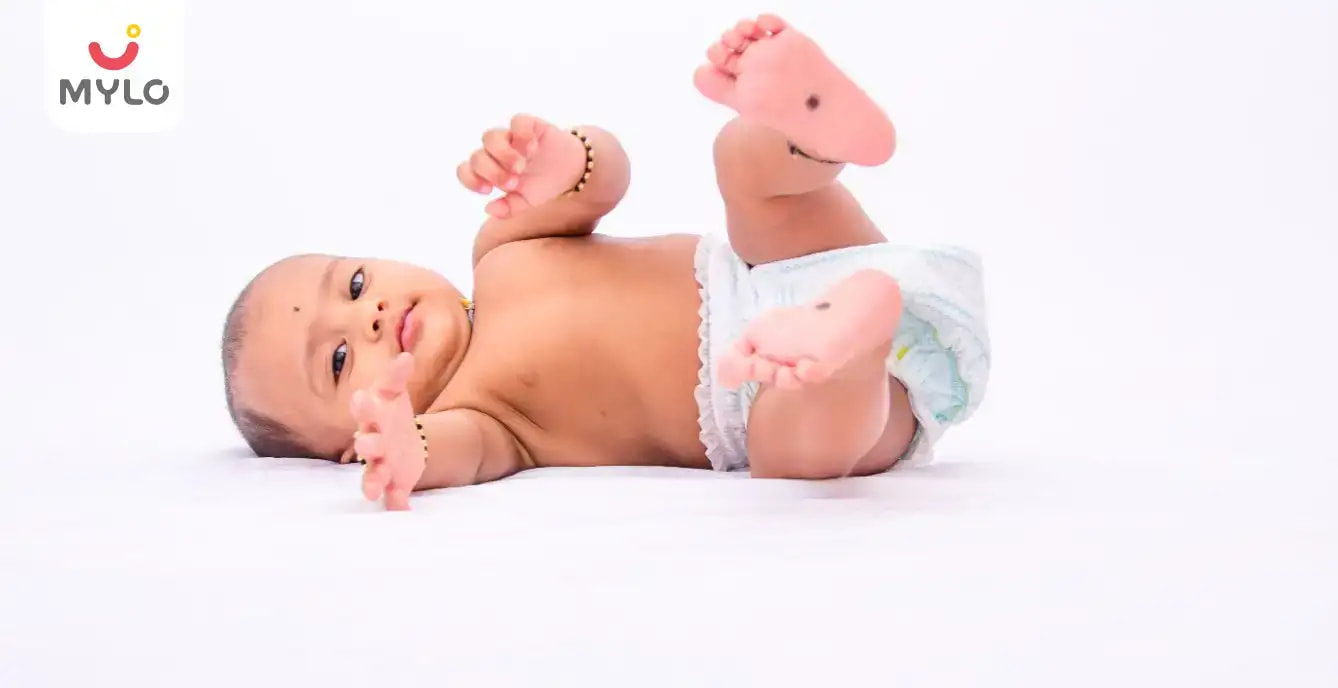Home

Baby Care

Top 5 Reasons Why Using a Baby Growth Tracker is Important
In this Article

Baby Care
Top 5 Reasons Why Using a Baby Growth Tracker is Important
Updated on 3 November 2023
What is a Baby Growth Tracker?
As the name suggests, a Baby Growth Tracker works as a measure to help understand the growth of a child. A baby tracker is highly suggested to be used for an infant and up to the age of 2 years minimum. This is because these are the crucial and sensitive years of growth where a child undergoes a series of changes. The growth of every baby is different. Moreover, if he or she isn’t growing at the ‘normal’ pace, it is natural for the parents to be concerned. This is when a growth tracker comes to help.
From food consumption to sleeping patterns, tracking a child’s growth works best for the long run. Parents can understand and take necessary steps as and when required. They can track the physical developments, which include weight, length and head circumference. While some may come across a wide range of baby tracking charts in the market, it is highly recommended to follow the standard growth Baby Tracker by WHO (World Health Organization). It is perfect for monitoring the growth of a child with the right statistics to avoid unnecessary confusion.
What is the Importance of a Baby Growth Tracker?
The importance of a Baby Tracker is important for many reasons. It helps parents understand an almost accurate percentile of the different physical, mental and physiological growth changes. Here are the top five reasons why using a baby growth tracker is important:
Reason 1: A Baby Growth Tracker proves essential for parents to check the weight of the baby from the date of birth to several months.
Reason 2: The second reason to use a tracker is to check the height of the baby during the different months.
Reason 3: A baby growth tracker also helps track the weight of a baby according to his/her current length.
Reason 4 – Head Circumference Check: The circumference of a baby’s head changes as they grow. Hence, one can find the head circumference measurement as required using a tracker.
Reason 5 – Thorough Assessment: With a baby tracker, parents can properly get a thorough assessment of their baby’s physical growth as mentioned above. This will help parents give detailed information to their paediatrician, who can then provide them with further solutions as and when required.
To start a child’s tracking process, one can follow these links:
WHO Growth Charts
(Recommended from birth to 24 months)
CDC Growth Charts
How Does a Baby Growth Tracker Work?
To use a Baby Tracker is pretty easy, and here’s how parents can do so:
Weight Check: Head to the right side of the CDC grid. Next, find the child’s age according to his/her month at the top and carefully follow the respective lines going horizontally and vertically till the point they intersect on the curved line. Finally, one needs to follow the particular curved line till the end, where the percentiles are written in white colour.
Height Check: To find the baby’s height or length, head to the left side of the grid and find the age in months towards the bottom. Next, track the respective lines that are going horizontally and vertically till the intersection on the growth curve. This curve then needs to be followed till the end, where the percentiles are written in white colour.
Weight Check for Length: Parents will need to head to the bottom of the grid, where they will find the baby’s weight on the left side of the grid. They will then have to follow the lines going horizontally and vertically of the measurements till the intersection on the growth curve and then follow the curve till the end to find the percentile.
Head Circumference Check: Parents will need to go towards the chart's left side and then follow the horizontal and vertical lines till the intersection in the curved line (in most cases) and follow the curve till the end, where they will see a number in white colour.
Conclusion
There is no restriction in using the CDC growth charts till the particular age of the baby. It can be used from the date of birth to the age of 19. However, the WHO growth chart can be used from an infant till the child is 5 years of age. The use of the charts of both CDC and WHO are similar. Overall, parents can experience the joy of watching their children grow and change every day.



Written by
Priyanka Verma
Priyanka is an experienced editor & content writer with great attention to detail. Mother to an 11-year-old, she's a ski
Read MoreGet baby's diet chart, and growth tips

Related Articles
Related Questions
Hello frnds..still no pain...doctor said head fix nhi hua hai..bt vagina me pain hai aur back pain bhi... anyone having same issues??

Kon kon c chije aisi hai jo pregnancy mei gas acidity jalan karti hain... Koi btayega plz bcz mujhe aksar khane ke baad hi samagh aata hai ki is chij se gas acidity jalan ho gyi hai. Please share your knowledge

I am 13 week pregnancy. Anyone having Storione-xt tablet. It better to have morning or night ???

Hlo to be moms....i hv a query...in my 9.5 wk i feel body joint pain like in ankle, knee, wrist, shoulder, toes....pain intensity is high...i cnt sleep....what should i do pls help....cn i cosult my doc.

Influenza and boostrix injection kisiko laga hai kya 8 month pregnancy me and q lagta hai ye plz reply me

Related Topics
RECENTLY PUBLISHED ARTICLES
our most recent articles

Diet & Nutrition
গর্ভাবস্থায় আলুবোখরা: উপকারিতা ও ঝুঁকি | Prunes During Pregnancy: Benefits & Risks in Bengali

Diet & Nutrition
গর্ভাবস্থায় হিং | ঝুঁকি, সুবিধা এবং অন্যান্য চিকিৎসা | Hing During Pregnancy | Risks, Benefits & Other Treatments in Bengali

Women Specific Issues
স্তনের উপর সাদা দাগ: লক্ষণ, কারণ এবং চিকিৎসা | White Spots on Nipple: Causes, Symptoms, and Treatments in Bengali

Diet & Nutrition
গর্ভাবস্থায় পোহা: উপকারিতা, ধরণ এবং রেসিপি | Poha During Pregnancy: Benefits, Types & Recipes in Bengali

Diet & Nutrition
গর্ভাবস্থায় মাছ: উপকারিতা এবং ঝুঁকি | Fish In Pregnancy: Benefits and Risks in Bengali

Diet & Nutrition
গর্ভাবস্থায় রেড ওয়াইন: পার্শ্ব প্রতিক্রিয়া এবং নির্দেশিকা | Red Wine During Pregnancy: Side Effects & Guidelines in Bengali
- ইনার থাই চ্যাফিং: কারণ, উপসর্গ এবং চিকিৎসা | Inner Thigh Chafing: Causes, Symptoms & Treatment in Bengali
- গর্ভাবস্থায় ব্রাউন রাইস: উপকারিতা ও সতর্কতা | Brown Rice During Pregnancy: Benefits & Precautions in Bengali
- Velamentous Cord Insertion - Precautions, Results & Safety
- Unlock the Secret to Flawless Skin: 7 Must-Have Qualities in a Face Serum
- Unlock the Secret to Radiant Skin: How Vitamin C Serum Can Transform Your Complexion
- Gender No Bar: 10 Reasons Why Everyone Needs a Body Lotion
- Unlock the Secret to Radiant Skin How to Choose the Perfect Body Lotion for Your Skin Type
- Top 10 Reasons to Apply a Body Lotion After Every Bath
- Communication in Toddlers: Milestones & Activities
- How to Improve Vocabulary for Toddlers?
- A Comprehensive Guide to Understanding Placenta Accreta
- Vulvovaginitis in Toddlers Causes, Symptoms and Treatment
- A Comprehensive Guide to Understanding Cerebral Palsy in Children
- Bitter Taste in Mouth During Pregnancy: Understanding the Causes and Remedies


AWARDS AND RECOGNITION

Mylo wins Forbes D2C Disruptor award

Mylo wins The Economic Times Promising Brands 2022
AS SEEN IN
















- Mylo Care: Effective and science-backed personal care and wellness solutions for a joyful you.
- Mylo Baby: Science-backed, gentle and effective personal care & hygiene range for your little one.
- Mylo Community: Trusted and empathetic community of 10mn+ parents and experts.
Product Categories
baby carrier | baby soap | baby wipes | stretch marks cream | baby cream | baby shampoo | baby massage oil | baby hair oil | stretch marks oil | baby body wash | baby powder | baby lotion | diaper rash cream | newborn diapers | teether | baby kajal | baby diapers | cloth diapers |








